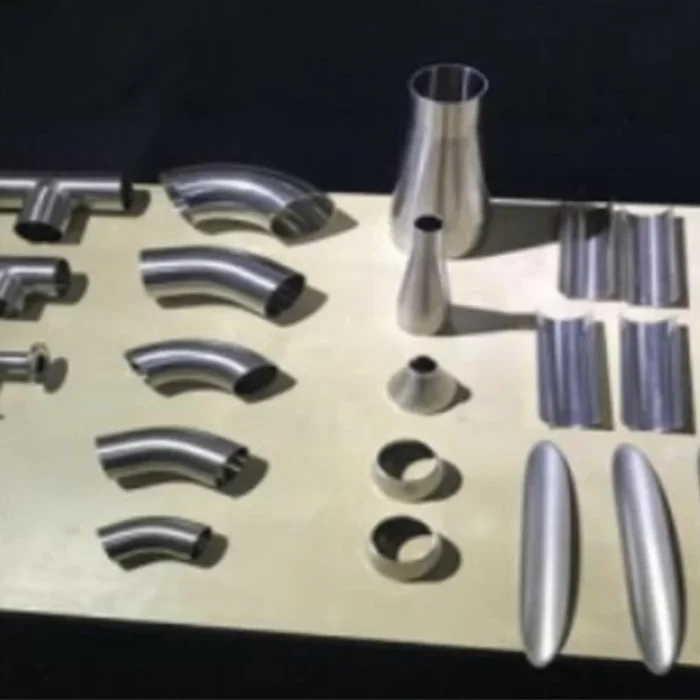Stainless steel pipe fittings are essential components in various industries, offering durability and corrosion resistance. These fittings provide a secure connection for piping systems, ensuring efficient fluid or gas flow. From threaded elbows to couplings, stainless steel pipe fittings come in a range of shapes and sizes to suit different applications. Their versatility and strength make them ideal for demanding environments where reliability is paramount. Whether used in plumbing systems or industrial settings, stainless steel pipe fittings play a crucial role in maintaining seamless operations while withstanding harsh conditions.
Overview of Stainless Steel Pipe Fittings
Durability and Corrosion Resistance
Stainless steel pipe fittings are known for their durability and corrosion resistance. These qualities make them ideal for various applications where exposure to harsh environments is a concern. For instance, in industries such as chemical processing or oil and gas, stainless steel fittings can withstand corrosive substances without deteriorating. This durability ensures that the fittings have a long lifespan, reducing the need for frequent replacements.
Stainless steel pipe fittings are manufactured using high-quality materials that offer exceptional resistance to corrosion from chemicals, moisture, and other elements. The chromium content in stainless steel forms a protective layer on the surface of the fitting, preventing rust and corrosion. As a result, these fittings maintain their integrity even when exposed to challenging conditions over an extended period. This corrosion resistance is crucial in ensuring the reliability of piping systems in critical applications like food processing plants or pharmaceutical facilities.
Secure Connections for Efficient Fluid Flow
One of the primary functions of stainless steel pipe fittings is to establish secure connections between pipes to facilitate efficient fluid flow within a system. These fittings come in various types such as elbows, tees, couplings, and reducers designed to join different sections of piping together seamlessly. By creating leak-free connections between pipes of varying sizes or shapes, stainless steel fittings help maintain system integrity while ensuring smooth fluid transfer throughout the network.
Pros:
Durable material
Corrosion-resistant
Long lifespan
Reliable performance
Types of Stainless Steel Fittings and Their Uses
Elbows
Elbows are crucial stainless steel pipe fittings that help change the direction of pipes. They come in various angles like 45 or 90 degrees, allowing for smooth directional changes. For instance, a plumber might use a 90-degree elbow to redirect a pipe around an obstacle without creating unnecessary bends.
Elbows:
Essential for changing pipe direction
Available in different angle options
Tees
Tees are another type of stainless steel fitting used when branching off into multiple directions is necessary. Picture a "T" shape where one end connects to the main line while the other two allow pipes to branch out horizontally or vertically. Plumbers use tees when adding new lines off existing ones.
Tees:
Used for branching into multiple directions
Ideal for expanding piping systems
Reducers and Couplings
Reducers play a vital role in connecting pipes with different diameters seamlessly. By using reducers, plumbers can join larger pipes to smaller ones efficiently without compromising flow rates or causing leaks. On the other hand, couplings provide quick connections between two pipes without needing extensive tools or complicated procedures. These fittings ensure secure joints while simplifying installation processes.
Reducers and Couplings:
Connects pipes with varying diameters effectively
Facilitates quick and easy pipe connections
Understanding Different End Styles in Pipe Fittings
Threaded Ends
Stainless steel pipe fittings can feature various end styles, including threaded, socket weld, butt weld, or flanged ends. Threaded ends are convenient for installation as they involve simply screwing the fitting onto the pipe. This type of end is commonly used in low-pressure applications where easy assembly and disassembly are necessary. Threaded connections are ideal for situations that require frequent maintenance or repairs, allowing for quick adjustments without specialized tools.
Threaded Ends:
Easy to install by screwing onto the pipe
Suitable for low-pressure applications requiring simple assembly and disassembly
Welded Ends
On the other hand, socket weld and butt weld ends necessitate welding to ensure a secure connection between pipes and fittings. Socket weld ends involve inserting the pipe into the fitting before welding them together, creating a strong joint resistant to leakage. Butt weld ends require similar welding but involve aligning the pipes directly against each other before joining them permanently through welding. These types of connections offer enhanced strength and durability compared to threaded ends but require more labor-intensive installation processes.
Welded Ends:
Socket weld: Insert pipe into fitting before welding for leak-resistant joints.
Butt weld: Align pipes directly against each other before permanent welding.
Flanged Ends
Flanged ends provide a bolted connection method that involves securing two flanges together with bolts, nuts, and gaskets to create a tight seal between pipes and fittings. This style allows for easy disassembly when needed while maintaining a robust connection suitable for high-pressure applications like industrial piping systems where leakage prevention is crucial.
Flanged Ends:
Bolted connection using bolts, nuts, and gaskets
Ideal for high-pressure applications requiring leak-proof seals
Importance of Material Types for Piping Applications
Stainless Steel
Stainless steel pipe fittings are essential in various industries due to their resistance to corrosion, high temperatures, and chemicals. These properties make them ideal for applications where durability and longevity are crucial. For instance, in the food processing industry, stainless steel fittings prevent contamination and ensure a hygienic environment.
Pros:
Resistant to corrosion
Durable and long-lasting
Suitable for high-temperature environments
Carbon Steel and PVC
While stainless steel is versatile, other materials like carbon steel or PVC have their advantages based on specific requirements. Carbon steel pipe fittings are known for their strength and suitability for high-pressure applications such as oil refineries. On the other hand, PVC fittings are lightweight, easy to install, and cost-effective but may not be suitable for all environments.
Carbon Steel:
Ideal for high-pressure applications.
Known for its strength and durability.
PVC:
Lightweight and easy to install.
Cost-effective alternative but may not be suitable in all scenarios.

Proper Installation Tips for Stainless Steel Pipe Fittings
Thorough Cleaning Process
Before installing stainless steel pipe fittings, it is crucial to clean the pipe ends and fittings properly. By removing any dirt or debris, you ensure a smooth and secure connection. This step helps prevent contamination and blockages that could affect the efficiency of the piping system.
It's essential to use a suitable sealant or thread tape during installation. This ensures a tight seal between the fittings, preventing leaks. The application of sealant also helps protect against corrosion in stainless steel fittings, prolonging their lifespan and maintaining optimal performance.
Correct Tightening Techniques
Using the correct tools and techniques for tightening stainless steel pipe fittings is vital to avoid damage. Over-tightening can harm the threads on both the fitting and the pipe, leading to leaks or even breakage. It is recommended to follow manufacturer guidelines regarding torque values for specific fittings.
When tightening stainless steel pipe fittings, always use a calibrated torque wrench to achieve precise tightening without causing damage. Be cautious not to exceed the recommended torque levels as this can compromise the integrity of the connection.
Maintenance Tips for Long-lasting Pipe Fittings
Regular Inspection
Regularly check stainless steel pipe fittings for corrosion, leaks, or damage. Inspecting them frequently helps catch issues early. Look closely at joints and connections to ensure there are no signs of wear or deterioration. By doing this, you can prevent potential leaks or failures in the system.
It's essential to inspect the fittings after installation and periodically thereafter. This practice ensures that any problems are identified promptly before they escalate into more significant issues. If you notice any concerns during your inspection, address them immediately to maintain the efficiency and longevity of your piping system.
Cleaning and Replacement
Clean pipe fittings periodically to remove buildup or deposits that might affect their performance over time. Use appropriate cleaning agents and tools to ensure thorough cleaning without damaging the fittings themselves. Keeping them clean enhances their durability and prevents blockages that could disrupt the flow within the system.
If you find worn-out gaskets or seals during inspections, replace them promptly to uphold the integrity of your piping system. Faulty gaskets can lead to leaks, reducing the effectiveness of your plumbing setup. By replacing these components when needed, you prevent potential water damage and maintain optimal functionality.
Choosing the Right Stainless Steel Pipe Fittings
Factors to Consider
When selecting stainless steel pipe fittings, several crucial factors must be taken into account. The application where the fittings will be used, the type of fluid they will handle, pressure ratings, and temperature requirements are essential considerations. For instance, in high-pressure systems, choosing fittings with a higher pressure rating is critical to ensure safety and optimal performance.
Consulting with experts or engineers can provide valuable insights into determining the most suitable fitting design and material for specific needs. These professionals can offer guidance on selecting the right stainless steel grade that offers corrosion resistance and durability based on the application's demands.
Making an Informed Decision
To make an informed decision when purchasing pipe fittings, it is advisable to compare prices from different suppliers. While cost is a significant factor, quality should not be compromised. Considering warranties offered by manufacturers can provide assurance of product reliability and after-sales support if needed. Moreover, reading customer reviews can offer valuable feedback on the performance and durability of different stainless steel pipe fittings brands.
Pros:
Corrosion-resistant
Durable
Suitable for various applications

Closing Thoughts
In conclusion, understanding the nuances of stainless steel pipe fittings is crucial for ensuring the efficiency and longevity of piping systems. By recognizing the various types, end styles, material considerations, installation techniques, and maintenance practices, individuals can make informed decisions when selecting and utilizing these fittings in diverse applications. Choosing the right stainless steel pipe fittings not only enhances performance but also contributes to the overall safety and reliability of the system.
For those venturing into the realm of stainless steel pipe fittings, thorough research and adherence to best practices are paramount. Continuous learning about advancements in materials and techniques is advised to stay abreast of industry standards. By implementing the insights shared in this comprehensive guide, individuals can navigate the complexities of stainless steel pipe fittings with confidence and precision.
Frequently Asked Questions
What are the common types of stainless steel pipe fittings available?
Stainless steel pipe fittings commonly include elbows, tees, reducers, couplings, and flanges. Each type serves a specific purpose in piping systems.
How should one properly install stainless steel pipe fittings?
Ensure proper alignment, use appropriate tools for tightening connections to recommended torque values, inspect for leaks post-installation, and follow manufacturer guidelines for installation procedures.
Why is it important to consider different end styles in stainless steel pipe fittings?
Different end styles such as threaded or socket weld play a crucial role in determining how pipes connect and interact with other components within a system. Choosing the right end style ensures proper functionality and compatibility.
What maintenance tips can prolong the lifespan of stainless steel pipe fittings?
Regularly inspecting for corrosion or damage, promptly addressing any leaks or issues detected during inspections, cleaning fittings as needed to prevent buildup or blockages can help maintain the longevity of stainless steel pipe fittings.
How does choosing the right material type impact piping applications when selecting stainless steel pipe fittings?
Selecting the appropriate material type based on factors like temperature range, pressure requirements, chemical compatibility ensures optimal performance and longevity of piping systems. Different material types offer varying levels of corrosion resistance and durability tailored to specific applications.








